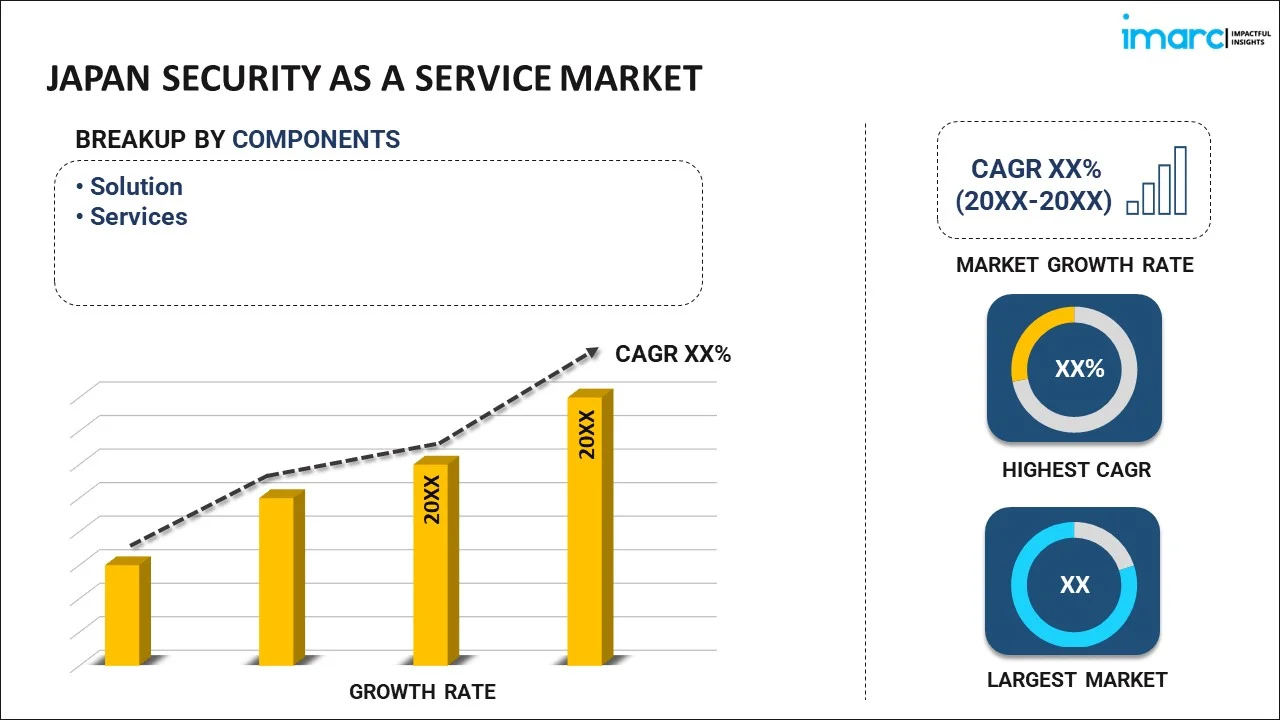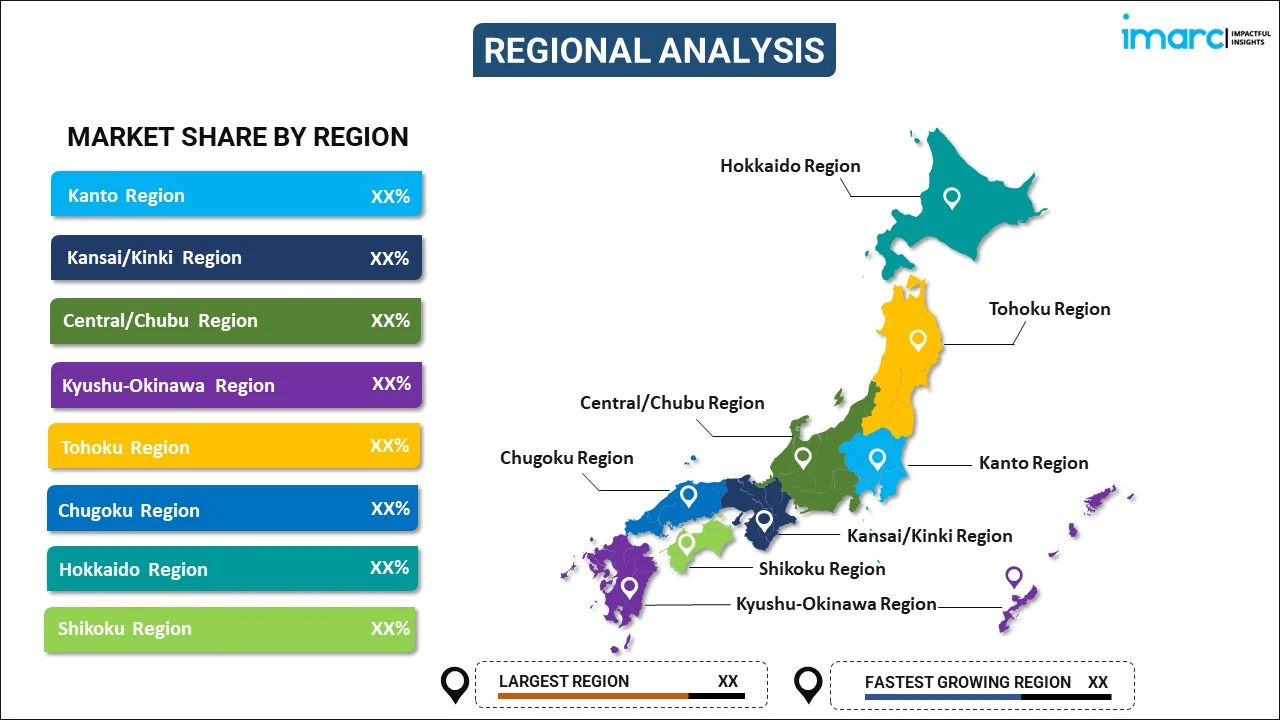
Japan Security as a Service Market Report by Component (Solution, Services), Organization Size (Small and Medium-sized Enterprises, Large Enterprises), Application (Network Security, Endpoint Security, Application Security, Cloud Security, and Others), Vertical (BFSI, Government and Defense, Retail and E-Commerce, Healthcare and Life Sciences, IT and Telecom, Energy and Utilities, Manufacturing, and Others), and Region 2025-2033
Market Overview:
Japan security as a service market size reached USD 1.0 Billion in 2024. Looking forward, IMARC Group expects the market to reach USD 3.8 Billion by 2033, exhibiting a growth rate (CAGR) of 14.3% during 2025-2033. The increasing incidences of cyber threats, including malware, ransomware, phishing, and data breaches, coupled with the escalating demand for cybersecurity that offers specialized expertise and solutions to protect against these threats, are driving the market.
|
Report Attribute
|
Key Statistics
|
|---|---|
|
Base Year
|
2024
|
|
Forecast Years
|
2025-2033
|
|
Historical Years
|
2019-2024
|
|
Market Size in 2024
|
USD 1.0 Billion |
|
Market Forecast in 2033
|
USD 3.8 Billion |
| Market Growth Rate 2025-2033 | 14.3% |
Security as a service (SECaaS) is a cloud-based cybersecurity model that offers organizations a range of security solutions and tools on a subscription basis. Instead of investing in and managing their own on-premises security infrastructure, businesses can leverage SECaaS to outsource various security functions to third-party providers. These services often include features like firewall protection, intrusion detection and prevention, antivirus, data encryption, and security monitoring. SECaaS offers several advantages, including cost savings, scalability, and access to cutting-edge security technologies. It allows organizations to focus on their core business activities while leaving the complexities of cybersecurity to experts. Additionally, SECaaS providers typically stay up-to-date with the latest threats and vulnerabilities, ensuring that their clients' systems are well-protected. However, organizations must carefully select an SECaaS provider that aligns with their security needs and compliance requirements. While it can enhance security posture, it's essential to maintain oversight and transparency regarding data protection when using SECaaS.
Japan Security as a Service Market Trends:
The security as a service market in Japan is poised for significant growth in the coming years, primarily due to several compelling market drivers. Firstly, the rapid proliferation of cloud computing and the increasing adoption of remote work models have created a heightened need for robust cybersecurity solutions. Consequently, organizations are turning to SECaaS to secure their data and networks, driven by the convenience and scalability it offers. Moreover, the evolving threat landscape characterized by sophisticated cyberattacks necessitates advanced security measures. SECaaS providers leverage cutting-edge technology, including artificial intelligence and machine learning, to proactively detect and mitigate threats, making them an attractive option for businesses seeking comprehensive protection. Additionally, the ever-changing regulatory environment is pressuring companies to comply with stringent data protection laws. SECaaS providers offer compliance management services, helping organizations adhere to these regulations without the burden of in-house compliance expertise. Furthermore, the widespread utilization of outsourcing security functions, which helps companies to reduce capital expenditures on hardware and software while benefiting from 24/7 monitoring and support, is expected to drive the security as a service market in Japan during the forecast period.
Japan Security as a Service Market Segmentation:
IMARC Group provides an analysis of the key trends in each segment of the market, along with forecasts at the country level for 2025-2033. Our report has categorized the market based on component, organization size, application, and vertical.
Component Insights:

- Solution
- Services
The report has provided a detailed breakup and analysis of the market based on the component. This includes solution and services.
Organization Size Insights:
- Small and Medium-sized Enterprises
- Large Enterprises
A detailed breakup and analysis of the market based on the organization size have also been provided in the report. This includes small and medium-sized enterprises and large enterprises.
Application Insights:
- Network Security
- Endpoint Security
- Application Security
- Cloud Security
- Others
The report has provided a detailed breakup and analysis of the market based on the application. This includes network security, endpoint security, application security, cloud security, and others.
Vertical Insights:
- BFSI
- Government and Defense
- Retail and E-Commerce
- Healthcare and Life Sciences
- IT and Telecom
- Energy and Utilities
- Manufacturing
- Others
A detailed breakup and analysis of the market based on the vertical have also been provided in the report. This includes BFSI, government and defense, retail and E-commerce, healthcare and life sciences, IT and telecom, energy and utilities, manufacturing, and others.
Regional Insights:

- Kanto Region
- Kansai/Kinki Region
- Central/ Chubu Region
- Kyushu-Okinawa Region
- Tohoku Region
- Chugoku Region
- Hokkaido Region
- Shikoku Region
The report has also provided a comprehensive analysis of all the major regional markets, which include Kanto Region, Kansai/Kinki Region, Central/ Chubu Region, Kyushu-Okinawa Region, Tohoku Region, Chugoku Region, Hokkaido Region, and Shikoku Region.
Competitive Landscape:
The market research report has also provided a comprehensive analysis of the competitive landscape. Competitive analysis such as market structure, key player positioning, top winning strategies, competitive dashboard, and company evaluation quadrant has been covered in the report. Also, detailed profiles of all major companies have been provided.
Japan Security as a Service Market Report Coverage:
| Report Features | Details |
|---|---|
| Base Year of the Analysis | 2024 |
| Historical Period | 2019-2024 |
| Forecast Period | 2025-2033 |
| Units | Billion USD |
| Scope of the Report | Exploration of Historical Trends and Market Outlook, Industry Catalysts and Challenges, Segment-Wise Historical and Future Market Assessment:
|
| Components Covered | Solution, Services |
| Organization Sizes Covered | Small and Medium-sized Enterprises, Large Enterprises |
| Applications Covered | Network Security, Endpoint Security, Application Security, Cloud Security, Others |
| Verticals Covered | BFSI, Government and Defense, Retail and E-Commerce, Healthcare and Life Sciences, IT and Telecom, Energy and Utilities, Manufacturing, Others |
| Regions Covered | Kanto Region, Kansai/Kinki Region, Central/ Chubu Region, Kyushu-Okinawa Region, Tohoku Region, Chugoku Region, Hokkaido Region, Shikoku Region |
| Customization Scope | 10% Free Customization |
| Post-Sale Analyst Support | 10-12 Weeks |
| Delivery Format | PDF and Excel through Email (We can also provide the editable version of the report in PPT/Word format on special request) |
Key Questions Answered in This Report:
- How has the Japan security as a service market performed so far and how will it perform in the coming years?
- What has been the impact of COVID-19 on the Japan security as a service market?
- What is the breakup of the Japan security as a service market on the basis of component?
- What is the breakup of the Japan security as a service market on the basis of organization size?
- What is the breakup of the Japan security as a service market on the basis of application?
- What is the breakup of the Japan security as a service market on the basis of vertical?
- What are the various stages in the value chain of the Japan security as a service market?
- What are the key driving factors and challenges in the Japan security as a service?
- What is the structure of the Japan security as a service market and who are the key players?
- What is the degree of competition in the Japan security as a service market?
Key Benefits for Stakeholders:
- IMARC’s industry report offers a comprehensive quantitative analysis of various market segments, historical and current market trends, market forecasts, and dynamics of the Japan security as a service market from 2019-2033.
- The research report provides the latest information on the market drivers, challenges, and opportunities in the Japan security as a service market.
- Porter's five forces analysis assist stakeholders in assessing the impact of new entrants, competitive rivalry, supplier power, buyer power, and the threat of substitution. It helps stakeholders to analyze the level of competition within the Japan security as a service industry and its attractiveness.
- Competitive landscape allows stakeholders to understand their competitive environment and provides an insight into the current positions of key players in the market.
Need more help?
- Speak to our experienced analysts for insights on the current market scenarios.
- Include additional segments and countries to customize the report as per your requirement.
- Gain an unparalleled competitive advantage in your domain by understanding how to utilize the report and positively impacting your operations and revenue.
- For further assistance, please connect with our analysts.
 Inquire Before Buying
Inquire Before Buying
 Speak to an Analyst
Speak to an Analyst
 Request Brochure
Request Brochure
 Request Customization
Request Customization




.webp)




.webp)












